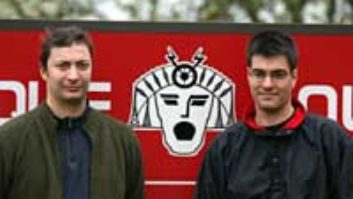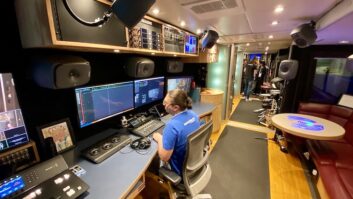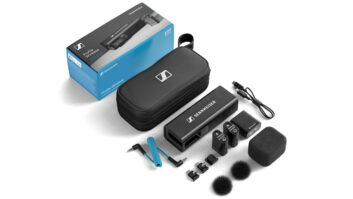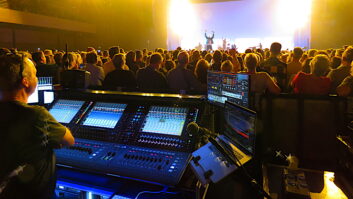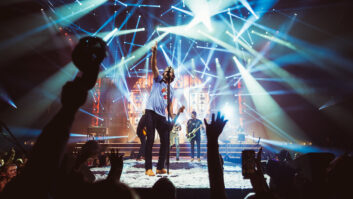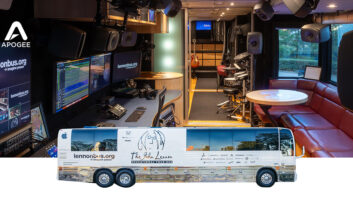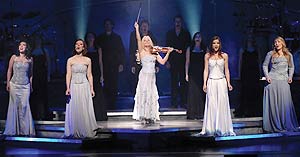
Against a twinkling backdrop of stars, a woman appears, holding a fiddle, dancing lithely in a long dress and playing a Celtic melody. She passes between two drummers, each with a modern drum kit and an arsenal of traditional percussion instruments. Enter four women in elegant evening gowns, backed by an eight-person choir, singing rich harmonies with virtuosic precision as the fiddler continues her dance.
Celtic Woman: A New Journey is the third installment in the Celtic Woman series. Built to showcase four outstanding Irish female vocalists and the fiddler, Máiréad, the series is the brainchild of executive producer Dave Kavanagh and David Downes, the musical director of that other popular Irish export, Riverdance. As its drum setup suggests, Celtic Woman is a mix of modern and traditional. Songs include Irish standards like “Danny Boy” weaving alongside hits by Enya and Josh Groban, as well as originals by Downes. Celtic Woman began as a PBS special, a one-time concert broadcast live from Dublin in 2004. Its massive popularity and accompanying CD/DVD prompted the organization to take the show on the road, resulting in a combined seven U.S. and world tours, and two follow-up CDs and TV broadcasts. The CDs have secured the top three spots on Billboard’s World Music charts for a record 95 weeks, and the tours have played in such places as Carnegie Hall and Radio City Music Hall, as well as the International Forum in Tokyo and The Point in Dublin. The current outing began in February in Dallas, and played across the States through May, ending in Los Angeles’ Greek Theatre.
CREATING THE LIVE FEEL
Wayne Pauley, the show’s front-of-house engineer since 2006, helped with the systems design as the show’s venues grew. “My part has been to take the vision of David Downes and [record producer] Andrew Boland and try and interpret that into a live format,” he says. “The people that come see this show have a very high expectation. I make sure that every seat in the house gets the best possible show.
“The show started out as a theater show,” he continues. “The venues we started in were 1,500 to 2,500 seats. Now it’s grown substantially. Some arenas that we’ve played [are] somewhere between 7- and 9,000. When you take a theater show like this and put it in an arena, you really have to treat it like it’s a very unique animal. It’s not the kind of situation where you can just plug a bunch more speakers in and turn it up.”
Pauley chose Meyer Sound P.A. systems to handle the job, with 24 MILOs, 24 MICAs, 12 HP-700 subs, and six UPJs for sidefills and 10 UPMs for front-fills. “It’s a pretty substantial amount of gear to carry around because we do several different sizes of venues, from theaters to big theaters to arenas,” Pauley says. “Basically, carrying two P.A. systems has been just an enormous blessing. The fact that we can load into an arena and knock the socks off it, and the very next day load into a 2,500-seat theater and be just as intimate with it is really fantastic. We’ve been in arenas that were sold in what’s called 180 degrees. We don’t normally do that. So we were able to hang two normal arena arrays, and we used the theater arrays on the sides to do a side-hang or side-wash to cover those extra people on the sides.”
Pauley considers the P.A. to be ideal because it can handle the large variation in SPL due to the show’s many genres of music. “To me, the Meyer system has great fidelity at a lot of different volumes. [The show is] very quiet at times and very loud at times. It’s one of the few shows that I can literally say stretches from 85- or 90dB C-weighted to almost 110 C-weighted. To make something sound good at 110 and sound good at 85 dB is quite a task. And that’s one of the biggest reasons why I love this stuff.”

From left: Tom Stegemann (system tech), Jason Daliin (RF tech), Wayne Pauley (FOH), Gordon Adams (monitor engineer) and Jason McCarrick (system tech)
Pauley also appreciates the system’s software prediction program, MAPP. “It will let you optimize how you hang the P.A. best to suit the room for its height, angle, degrees of angle between the speakers so you know exactly what every seat’s going to sound like before you ever put a piece of P.A. in the air. It’ll show you through color graphs how loud or soft it’ll be in any one seat, and you can adjust the output of the speakers accordingly to make it a more smooth pattern so it’s just as loud at the back wall as the third row. It really helps in allowing us to make certain that everyone that comes to see the show has a great experience.”
MIXING IT UP
Because the show spans a wide variety of musical genres, Pauley often changes effects and settings. “When I started, the way it was explained to me was that every song is basically its own little entity and you should treat it accordingly,” he remembers. “And that’s not just with levels, but with tones and equalization and effects and everything. It’s basically like 30 different five-minute movies.”
To produce these changes, Pauley uses a TC Electronic M6000 reverb with a quad engine, essentially four units in one rackspace. “The show changes so much that what’s going on is drastically different from song to song, so some of them may be big, huge breathy kind of things and some of them may be short, sweet and to the point.” Pauley employs two long reverbs, a short plate and a delay on the unit.
The show is all-acoustic, with the exception of a DI bass. “I’ve always been of the school that if you have a good source tone and a good microphone and a good mic pre, you really don’t need anything else,” he says. Exhibit A are the more traditional-style “percussion toms,” which Pauley mikes with Sennheiser 604s. “To me, the 604s have a more neutral sound and it seems to have a little more of the ability to get the ambience of the drums.” The other instruments mainly get Sennheiser, as well. With the rock drums, Pauley calls on “rock ‘n’ roll” mics from Sennheiser’s evolution 900 Series: a 902 for kick, 905 on the snare and 904s around the toms. The orchestral bass drum and percussion bass get an MD 441, as does the woodwind player, who changes from flutes and pipes to traditional Irish whistles. Pauley uses a Neumann 184 and a KM 84 for the acoustic guitars and the bouzouki, a large mandolin-like instrument.
A DIGITAL MIXING LIFE
Both FOH and monitors are mixed on Yamaha PM1D consoles. “It seems like it’s the most user-friendly for us old analog guys, myself and Gordon Adams, the monitor engineer,” Pauley explains. “We both come from the old school, where a Midas XL3 was the top of the line. Going through changes — and you have to keep up with technology — and making the transfer over from analog to digital, the 1D seemed the most intuitive, especially being able to get to any control with two keystrokes at the most, whereas some consoles you have to page through layers and layers.”
Monitor engineer Gordon Adams hails from Canada, where he worked with fellow northerners Nelly Furtado and Randy Bachman of the Guess Who. On this tour for around 18 months, Adams says it’s one of the best gigs he’s ever had. “The women are an absolute joy to work with, as is everybody on this tour,” he says. “They all understand the limitations of the wireless environment, and sometimes we’re in a place where it’s a challenge to get absolute clarity due to TV, radio and other outside sources.
“They understand that I can’t erase the hall out of their mic into their ears, or I don’t want to try because if I chop the mix down a bit, then the next day we get into a theater it’ll be a very dark close mix, so they tend to leave it alone,” he adds. “And because there are a lot of people onstage, there’s a lot of mixes going on, so I’m glad it’s not a scramble on a day-to-day basis.”
Everyone onstage has Sennheiser 3000 and 5000 Series in-ears with 4061 and 4088 DPA headset mics. “Most of the people have Sensaphonic in-ear buds; I personally use Ultimate Ears UE-7s, which I had before I got this job,” Adams says. The monitor engineer also points out that to get a low-end response, the bass player and drummers have speaker transducers bolted to the drum thrones and the platform on which the bass player stands. “The band is a pretty easy bunch of guys to deal with,” he says. “They all have a realistic approach to what they want to hear in their monitors so I’m just changing pages; it’s all saved anyway. I’m following the show more than [making] constant updates to it.”
In the past, Pauley has engineered everything from rock and country to world music, but what he loves best about this gig is its challenges. “It’s the first time I’ve been involved with something that’s had so many styles and genres in one two-and-a-half-hour show,” he says. “You just don’t get this kind of complexity with any other show.”
Gaby Alter is a New York City-based writer.

